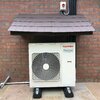One of the reasons I chose two Powerwalls was the charge rate capability.
They're really good actually. Charge at 10kW... even with our Car Charging at 7kW as well. Took a screenshot the other day with them at full power before I went to sleep.
Normally they'll throttle back at around 7kW, because that's always enough to get 27kWh stored in 4 hours... but I started the charge late, so they had less 'off-peak' time to do it in.
The 10kW charge rate can be useful if you're limited in some way by time period... or Grid availability, in between scheduled or unscheduled blackouts as an example.
View attachment 798029



